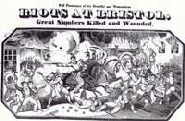The collection includes books and pamphlets, newspaper cuttings and engravings which provide a valuable insight into the Bristol Riots of 1831 when supporters of parliamentary reform rampaged across the city, looting property, freeing prisoners from the gaols, and setting fire to numerous buildings. The riots lasted for three days until they were finally, and brutally, put down by the military.
The material was complied by a Bristol attorney called Francis Jarman who mixed with influential writers and thinkers of the day. As well as such weighty documents as transcripts of the rioters' trials and eyewitness accounts of the looting, Jarman also collected some fascinating ephemera from the pages of more popular publications. This includes notices in newspapers offering cash rewards for information leading to the arrests of 'divers disorderly and wicked Persons', and luridly-illustrated accounts giving 'Full Particulars of the Dreadful and Tremendous RIOTS AT BRISTOL' printed by James Catnach, a London publisher famous for his gruesome accounts of recent murders.
Michael Richardson, Assistant Librarian of the University's Special Collections Department said: "We are delighted to have acquired such a valuable collection of contemporary source material on this terrible episode in Bristol's history. It's a very welcome addition to the material the University already holds on the riots, such as the diary of Isambard Kingdom Brunel who, finding himself at the Mansion House after it had been sacked by the mob, promptly armed himself with a chair back and went out to join the forces of law and order.
"The University also holds papers of Charles Pinney, Bristol's mayor at the time of the riots. Documents among these papers vividly convey the personal experiences of the Pinney family, including their evacuation to the relative safety of Clifton, the secrecy as to their whereabouts and their anxiety for one another."
The Bristol Riots lasted from Saturday 29 October to Monday 31 October 1831. They were sparked by a confrontation between an angry crowd supporting parliamentary reform and the ultra-Tory Recorder of Bristol, Sir Charles Wetherell, who embodied the old order in Parliament and the self-electing Corporation of Bristol.
By Sunday afternoon, the Mansion and Custom Houses and much of the rest of the north and west sides of Queen Square were ablaze, three prisons emptied of prisoners and alight, and the Bishop's Palace looted and on fire. On Monday morning, military force was at last employed and the streets cleared with considerable loss of life.
There was a public outcry at the destruction and the Corporation of Bristol and the military authorities were accused of failing to defend property. This led to courts martial and the prosecution of the mayor and Corporation. However, the mayor was later acquitted of neglect of duty and the prosecution of the Corporation was abandoned.
Francis Jarman served as a Liberal town councillor in the reformed Corporation as a representative of St James's Ward between 1841-1849. He died in 1849 aged 53.
